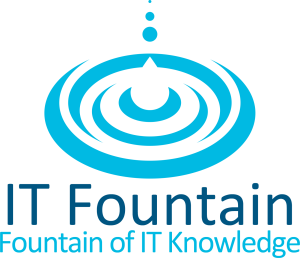Reconfiguring Microsoft Exchange Server To Use SAN Certificate With Only External Domain Names
Categories: Exchange
A typical Microsoft Exchange solution for SMEs might look like this:
Consequently a Subject Alternative Name (SAN) certificate will probably contain the following entries:
itexch01.itfountain.local
itexch02.itfountain.local
autodiscover.itfountain.com
mail.itfountain.com
The internal names are usually used for the Client Access Server (CAS) role and is what Outlook will connect to. For this reason the internal server names must be present in the certificate or Outlook will generate a warning like the following:
From November 2015 Certificate Authorities (CA) are prohibited from issuing certificates with internal domain names (https://cabforum.org/internal-names/).
To resolve this issue Exchange CAS internal URLs have to be changed to external fully qualified domain name (FQDN) such as mail.itfountain.com. A new DNS zone must be created and mail.itfountain.com must point to the internal IP of the CAS. The internal URL/URI used by Exchange must point to the newly created A record. After this is done a new certificate without the internal names can be used.
N.B. Don’t create zone for the actual domain i.e. itfountain.com or you will have to add all the existing A records in.
DNS Configuration
Launch DNS manager on your Active Directory (AD) server
Create a new zone in Forward Lookup Zones
I am going to name this zone mail.itfountain.com as I will name my CAS array that and point all the necessary internal URLs/URIs to this as well.
Create a new blank A record and point to the internal IP of the CAS array
Exchange Configuration
Once the DNS is done all the internal URLs/URIs in Exchange must be changed.
Check Exchange server details and where the roles are
Get-ExchangeServer | fl name, admindisplayversion, serverrole, site
Name : ITFEXCH01
AdminDisplayVersion : Version 14.3 (Build 123.4)
ServerRole : Mailbox, ClientAccess, HubTransport
Site : ITFOUNTAIN.local/Configuration/Sites/Default-First-Site-Name
Name : ITFEXCH02
AdminDisplayVersion : Version 14.3 (Build 123.4)
ServerRole : Mailbox, ClientAccess, HubTransport
Site : ITFOUNTAIN.local/Configuration/Sites/Default-First-Site-Name
Check the details of the CAS Array
Get-ClientAccessArray
Name Site Fqdn Members
——– —— ——– ————-
mail Default-First-Sit… itfcas.itfountain.local {ITFEXCH01, ITFEXCH02}
Get the details of the CAS role
Get-ClientAccessServer | fl name, auto*, iden*
Name : ITFEXCH01
AutoDiscoverServiceCN : ITFEXCH01
AutoDiscoverServiceClassName : ms-Exchange-AutoDiscover-Service
AutoDiscoverServiceInternalUri : https://ITFEXCH01.ITFOUNTAIN.LOCAL/autodiscover/autodiscover.xml
AutoDiscoverServiceGuid : 77378f46-2c66-4aa9-a6a6-3e7a48b19596
AutoDiscoverSiteScope : {Default-First-Site-Name}
Identity : ITFEXCH01
Name : ITFEXCH02
AutoDiscoverServiceCN : ITFEXCH02
AutoDiscoverServiceClassName : ms-Exchange-AutoDiscover-Service
AutoDiscoverServiceInternalUri : https://autodiscover.itfountain.com/autodiscover/autodiscover.xml
AutoDiscoverServiceGuid : 77378f46-2c66-4aa9-a6a6-3e7a48b19596
AutoDiscoverSiteScope : {Default-First-Site-Name}
Identity : ITFEXCH02
Get Web Services Virtual Directory details
Get-WebServicesVirtualDirectory | fl iden*, int*, ext*
Identity : ITFEXCH01\EWS (Default Web Site)
InternalNLBBypassUrl : https://itfexch01.itfountain.local/ews/exchange.asmx
InternalAuthenticationMethods : {Ntlm, WindowsIntegrated, WSSecurity}
InternalUrl : https://itfexch01.itfountain.local/ews/exchange.asmx
ExternalAuthenticationMethods : {Ntlm, WindowsIntegrated, WSSecurity}
ExtendedProtectionTokenChecking : None
ExtendedProtectionFlags : {}
ExtendedProtectionSPNList : {}
ExternalUrl : https://mail.itfountain.com/ews/exchange.asmx
Identity : ITFEXCH02\EWS (Default Web Site)
InternalNLBBypassUrl : https://itfexch02.itfountain.local/ews/exchange.asmx
InternalAuthenticationMethods : {Ntlm, WindowsIntegrated, WSSecurity}
InternalUrl : https://itfexch02.itfountain.local/ews/exchange.asmx
ExternalAuthenticationMethods : {Ntlm, WindowsIntegrated, WSSecurity}
ExtendedProtectionTokenChecking : None
ExtendedProtectionFlags : {}
ExtendedProtectionSPNList : {}
ExternalUrl : https://mail.itfountain.com/ews/exchange.asmx
Check Offline Address Book Virtual Directory
Get-OabVirtualDirectory | fl iden*, int*, ext*
Identity : ITFEXCH01\OAB (Default Web Site)
InternalUrl : https://itfexch01.itfountain.local/oab
InternalAuthenticationMethods : {WindowsIntegrated}
ExtendedProtectionTokenChecking : None
ExtendedProtectionFlags : {}
ExtendedProtectionSPNList : {}
ExternalUrl : https://mail.itfountain.com/OAB
ExternalAuthenticationMethods : {WindowsIntegrated}
Identity : ITFEXCH02\OAB (Default Web Site)
InternalUrl : https://itfexch02.itfountain.local/oab
InternalAuthenticationMethods : {WindowsIntegrated}
ExtendedProtectionTokenChecking : None
ExtendedProtectionFlags : {}
ExtendedProtectionSPNList : {}
ExternalUrl : https://mail.itfountain.com/OAB
ExternalAuthenticationMethods : {WindowsIntegrated}
So from the above commands we know the following needs to be changed:
AutodiscoverServiceInternalUri of the CAS
InternalURL of the WebServicesVirtualDirectory
InternalURL of OABVirtualDirectory
For completeness we will also recreate the CAS array as mail.itfountain.com
Remove CAS Array
Remove-ClientAccessArray
Recreate CAS Array with new name
New-ClientAccessArray
Restart IIS
iisreset
Check that all mailbox databases are part of the newly created CAS array
Get-MailboxDatabase | fl name,Rpc*
Name : IT Fountain UK
RpcClientAccessServer : mail.itfountain.com
Name : IT Fountain International
RpcClientAccessServer : mail.itfountain.com
Name : ITFGB
RpcClientAccessServer :
Looks like ITFGB is not part of the CAS array so will have to be set
get-mailboxdatabase | set-mailboxdatabase -rpcclientaccessserver “mail.itfountain.com”
Set the internal URLs to mail.itfountain.com
Set-ClientAccessServer -Identity ITFEXCH01 -AutodiscoverServiceInternalUri https://mail.itfountain.com/autodiscover/autodiscover.xml
Set-WebServicesVirtualDirectory -Identity “ITFEXCH01\EWS (Default Web Site)” -InternalUrl https://mail.itfountain.com/ews/exchange.asmx
Set-OABVirtualDirectory -Identity “ITFEXCH01\oab (Default Web Site)” -InternalUrl https://mail.itfountain.com/oab
Restart IIS
iisreset
Repeat these steps on the other Exchange server.
New Certificate
Launch Exchange Management Console, from server configuration launch the new certificate wizard
Generate a new request (CSR) to include the domains autodiscover.itfountain.com and mail.itfountain.com
Submit the CSR to your CA to obtain the new certificate, once you receive the certificate complete the request to install the new certificate.
Assign all necessary Exchange Services to the new certificate, in my case IMAP, POP, IIS and SMTP. Export the certificate from the first Exchange server and install it on the second Exchange server and the load balancers.
Do all the necessary testing.







No comments yet.